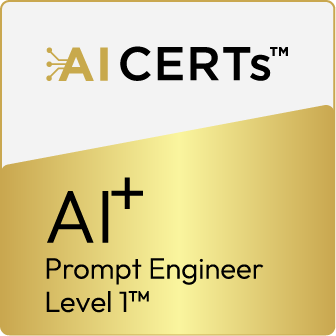Grab your seat NOW.
“The AI+Project Manager™ Τraining provided me with a comprehensive understanding of how AI can be applied to the planning and execution of projects. I learned how AI tools facilitate automation, data-driven decision-making, and team collaboration. At the same time, I deepened my knowledge of key Project Management principles such as risk analysis, time management, and stakeholder communication. Integrating AI into these processes enhanced my understanding of effective and flexible Project Management”.
"I highly recommend the AI + Project Manager™ course. The interactive approach and deep exploration of AI in PM were incredibly beneficial. The trainer kept all participants highly engaged and interested throughout.".
“I recently attended the AI+Human Resources™ training organized by Athens International College. Although I work in a software development company and am already familiar with the subject, I found the training extremely valuable. It offered a comprehensive perspective covering technical, HR, and ethical dimensions of AI in the workplace. The technical content was informative yet not overwhelming for a non-technical audience, and the practical applications were highly relevant. It’s clear that beyond HR, AI has the potential to disrupt and transform any organizational function, significantly boosting efficiency. I believe this is a must-have certification for any professional or organization aiming to stay competitive in today’s rapidly evolving business environment.”
“It was truly inspiring! An eye opener that clearly showed how AI can transform and optimize the entire recruitment process, as well as every aspect of HR. The sessions were dynamic, practical, engaging and packed with insights that every forward-thinking HR professional needs “.
"The 'AI + Human Resources™ Training' program by Athens International College was an outstanding experience. Through modern and practical content, I learned how Artificial Intelligence can enhance HR processes and strengthen my professional skills. It is an essential tool for any executive who wants to stay ahead of the curve and integrate new technologies into their daily work".
"Investing in AI education for business professionals is not just beneficial but necessary. It empowers us to embrace innovation, improve efficiency, and deliver better outcomes for our organizations. I highly recommend this training to anyone looking to stay ahead in the ever-changing business landscape".
"I recently attended the AI for Executives seminar and found it truly insightful and engaging. The tutor demonstrated deep knowledge of the subject and delivered the content in a clear, interactive way that kept us all involved. It was a very interesting experience, and I highly recommend it to any executive looking to better understand the impact and potential of AI in business."
"The AI+Executive training exceeded my expectations from the outset. The well-structured content was impressive, but the trainer's exceptional knowledge, skills, and engaging personality truly made it outstanding."
- Basic knowledge of AI concepts and applications for understanding advanced topics.
- Familiarity with Programming Languages such as Python or R
- Proficiency in Data Analysis and Interpretation
- Knowledge of Machine Learning Algorithms and Techniques
- Awareness of Ethical Issues and Considerations in AI Development
This comprehensive program is designed for professionals that want to learn how to leverage Artificial Intelligence to optimize their outcomes. It is addressed to any professional who wants to learn the best practices for designing effective prompts that harness the capabilities of AI models to their fullest potential.
1.1 Introduction to Artificial Intelligence
1.2 History of AI
1.3 Machine Learning Basics
1.4 Deep Learning and Neural Networks
1.5 Natural Language Processing (NLP)
1.6 Prompt Engineering Fundamentals
2.1 Introduction to the Principles of Effective Prompting
2.2 Giving Directions
2.3 Formatting Responses
2.4 Providing Examples
2.5 Evaluating Response Quality
2.6 Dividing Labor
2.7 Applying The Five Principles
2.8 Fixing Failing Prompts
3.1 Understanding AI Tools and Models
3.2 Deep Dive into ChatGPT
3.3 Exploring GPT-4
3.4 Revolutionizing Art with DALL-E 2
3.5 Introduction to Emerging Tools using GPT
3.6 Specialized AI Models
3.7 Advanced AI Models
3.8 Google AI Innovations
3.9 Comparative Analysis of AI Tools
3.10 Practical Application Scenarios
3.11 Harnessing AI’s Potential
4.1 Zero-Shot Prompting
4.2 Few-Shot Prompting
4.3 Chain-of-Thought Prompting
4.4 Ensuring Self-Consistency in AI Responses
4.5 Generate Knowledge Prompting
4.6 Prompt Chaining
4.7 Tree of Thoughts: Exploring Multiple Solutions
4.8 Retrieval Augmented Generation
4.9 Graph Prompting and Advanced Data Interpretation
4.10 Application in Practice: Real-Life Scenarios
4.11 Practical Exercises
5.1 Introduction to Image Models
5.2 Understanding Image Generation
5.3 Style Modifiers and Quality Boosters in Image Generation
5.4 Advanced Prompt Engineering in AI Image Generation
5.5 Prompt Rewriting for Image Models
5.6 Image Modification Techniques: Inpainting and Outpainting
5.7 Realistic Image Generation
5.8 Realistic Models and Consistent Characters
5.9 Practical Application of Image Model Techniques
6.1 Introduction to Project-Based Learning in AI
6.2 Selecting a Project Theme
6.3 Project Planning and Design in AI
6.4 AI Implementation and Prompt Engineering
6.5 Integrating Text and Image Models
6.6 Evaluation and Integration in AI Projects
6.7 Engaging and Effective Project Presentation
6.8 Guided Project Example
7.1 Introduction to AI Ethics
7.2 Bias and Fairness in AI Models
7.3 Privacy and Data Security in AI
7.4 The Imperative for Transparency in AI Operations
7.5 Sustainable AI Development: An Imperative for the Future
7.6 Ethical Scenario Analysis in AI: Navigating the Complex Landscape
7.7 Navigating the Complex Landscape of AI Regulations and Governance
7.8 Navigating the Regulatory Landscape: A Guide for AI Practitioners
7.9 Ethical Frameworks and Guidelines in AI Development
Access to educational material: All Trainees will get access to our LMS platform, where they will have all educational material, videos, blueprints, whitepapers, quizzes, as well as the certification process and the proctoring platform which monitors the exam. That way, they will have instant access to the material and the chance to prepare themselves for the certification process more efficiently.
Certification

Modules: 7
Examination: 1
Number of Questions: 50
Duration: 90 minutes
Passing score: 35/50 or 70%
Format: Online via AI proctoring platform
Question type: Multiple choice/multiple response
All Trainees will get the chance to get certified as an AI+ Prompt EngineerTM, after successful completion of the relevant exam, given through a proctoring platform. That way they will earn a Badge for their professional growth in the AI domain.
Upon successful completion of AI+ Prompt EngineerTM certification, participants will demonstrate proficiency in foundational AI concepts, principles of effective prompting, theoretical understanding of AI tools and models, prompt engineering techniques, image model concepts, and ethical considerations in AI. Participants will have acquired practical skills through project-based learning sessions and will be equipped to apply ethical frameworks in AI development. This certification signifies competence in AI prompt engineering and prepares individuals for ethical and innovative contributions to the field.
Konstantinos is a Computer Science professional with a strong academic background and hands-on experience in IT systems, digital infrastructure, and artificial intelligence. His expertise focuses on Data and Knowledge Management, especially in AI techniques like deep learning and transformers. He authored a published bachelor’s thesis during his studies at the National and Kapodistrian University of Athens, demonstrating his ability to turn theoretical knowledge into practical outcomes.
Konstantinos has worked in various IT roles, including IT Systems Manager at Athens International College and Technical Advisor for digital event solutions. His experience includes full-stack development and digital transformation projects.
As a certified AI Certs Trainer (AICT), Konstantinos combines technical expertise, teaching experience, and strategic thinking. He has also tutored students in mathematics, physics, and computer science for over five years.
His strengths include AI solution development, IT infrastructure, and process automation, with a focus on advancing intelligent systems in modern digital environments.
Discover Your Ideal Role-Based Training Programs and Certifications!
Not sure which programs to go for?
Call +30 2102114671 or fill the form below. An Education Consultant will help you discover the perfect role-based Training Programs and Certifications suited for you.
*Mandatory
